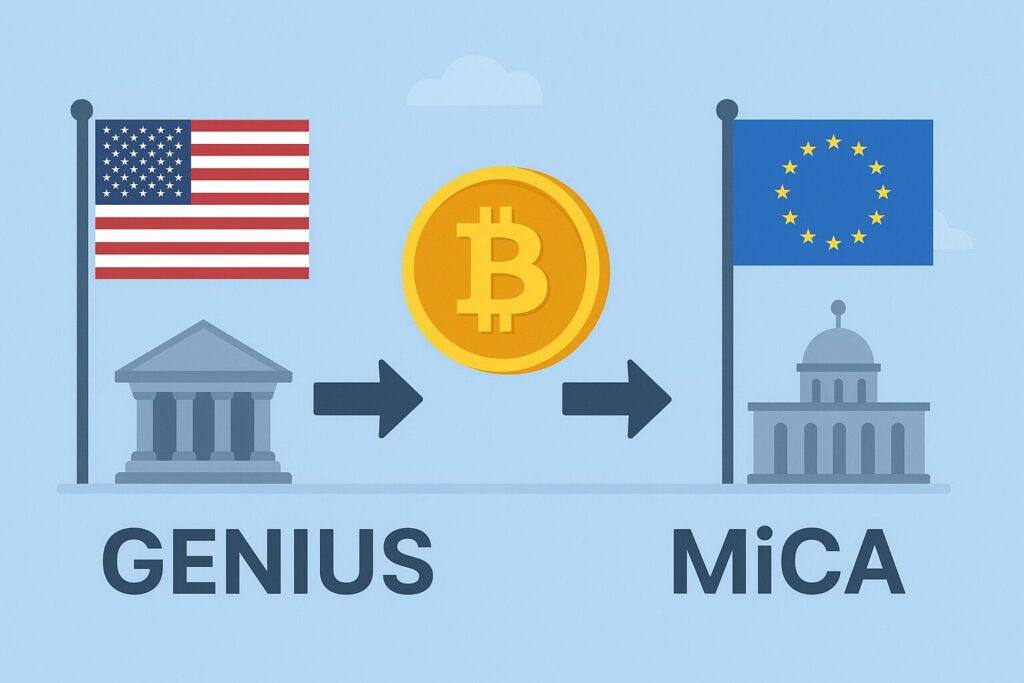The GENIUS Act introduced in the United States and the EU’s MiCA regulation both represent major shifts in crypto regulation, particularly focusing on stablecoin rules, consumer protection, and ensuring transparency for digital assets regulation. These laws mark turning points for how stablecoins are issued, supervised, and integrated into both U.S. and EU markets.

What is the U.S. GENIUS Act?
Overview of the Act
- The Guiding and Establishing National Innovation for US Stablecoins Act (GENIUS Act) was signed into law on July 18, 2025.
- It creates the first federal regulatory system for payment stablecoins, defining who can issue them, how reserves are handled, and how issuers are supervised.
Key Provisions & Technical/On-Chain Impacts
- 1:1 reserve backing with U.S. dollars or low-risk liquid assets like short-term Treasuries.
- Issuers required to publish monthly reports on reserve composition; auditors to verify.
- Strong AML / BSA requirements, risk management, capital & liquidity requirements.
- Issuers prohibited from marketing stablecoins as being U.S. government-backed, legal tender, or federally insured.
- Foreign stablecoin issuers can participate if their regulatory regime is deemed comparable, and if they meet certain supervision and reserve requirements.
What is EU’s MiCA Regulation?
Overview & Purpose
- Markets in Crypto-Assets Regulation (MiCA) is the EU’s comprehensive legal framework for crypto-assets not otherwise regulated. It entered into force in June 2023, with many provisions becoming fully applicable by December 30, 2024.
- MiCA covers asset-referenced tokens, e-money tokens, and crypto-asset service providers (CASPs). Its goals: transparency, market integrity, consumer protection.
Technical/On-Chain & Regulatory Provisions
- Issuers must meet disclosure, authorisation and supervision standards; CASPs need to get licenses.
- For stablecoins: reserve requirements, liquidity, redemption rights, transparency, and supervision.
- Enforcement of rules relating to market abuse, fraud, financial stability.
- Many on-chain implications: smart contract standards, risk of non-compliant protocols being cut off from EU markets; CASP licenses required for exchanges, wallets, etc.
Comparison & Alignment (GENIUS Act vs MiCA)
Where They Match
| Feature | GENIUS Act | MiCA |
|---|---|---|
| Stablecoin reserve backing | 1:1 with U.S. dollars or safe assets | Strong reserve, liquidity & redemption rules for stablecoins |
| Consumer protection | Marketing restrictions, transparency, reserve disclosure | Consumer risk disclosures, licensing, supervision |
| Transparency & Audit | Monthly reporting; reserve audit | Disclosure obligations; issuing whitepapers/technical info |
| Regulatory supervision | Federal and state oversight; foreign issuers under comparable regimes | Licensed national authorities + oversight by EU bodies |
Differences & Potential Conflicts
- Scope: GENIUS focuses mainly on payment stablecoins. MiCA covers a broader set of crypto-assets (e-money tokens, asset-referenced tokens, CASPs).
- Timing of enforcement: GENIUS Act has implementation deadlines (some provisions phased in), while MiCA has already begun enforcement in many member states.
- Regulatory bodies: In U.S., multiple federal & state regulators; in EU, national regulators plus oversight from ESMA.
- Cross-border participation: MiCA allows “passporting” (once licensed in one EU state, services can operate across many). Some issues have appeared, such as opposition to passporting if oversight is weak.
Technical & On-Chain Analysis
Smart Contract Risks & Protocol Compliance
- Under both regimes, smart contracts for stablecoins or tokenized assets must allow redemption, reserve audits, compliance with regulatory restrictions (freeze, transfer limits etc.). Projects that don’t include these may be at risk of non-license or sanctions.
Chain Data and On-Chain Signals
- Monitoring reserve backing: on-chain transparency tools (e.g., reserve wallets, proof-of-reserve) likely to gain importance.
- Volume flows between stablecoins & regulated entities: large transfers could signal arbitrage or risk.
- CASPs in EU must record user transactions, provenance of tokens, able to report suspicious activity; on-chain analytics will help regulatory compliance.
Impacts & Outcomes
For Projects & Businesses
- Projects issuing stablecoins will need to restructure reserve holdings, strengthen audit pipelines, possibly register in multiple jurisdictions.
- CASPs, wallets, exchanges need to ensure they meet both U.S. and EU rules if operating internationally: licensing, reporting, risk management.
- DeFi protocols without proper compliance may face limitations in access or users shifting to compliant platforms.
For Markets & Investors
- Increased regulatory clarity reduces uncertainty, can attract institutional capital.
- Likely reduction in scams, fraudulent stablecoins, and unstable tokens due to tighter oversight.
- Possible costs: compliance costs, slower innovation, barriers for smaller players.
Cause-Effect Dynamics
- Cause: The volatility of stablecoins, past collapses, lack of uniform rules.
Effect: Governments enact strong regulations (GENIUS Act & MiCA) to impose reserve, disclosure, supervision requirements. - Cause: Regulatory arbitrage (companies choosing lax jurisdictions) and fragmented rules.
Effect: MiCA’s passporting + EU bodies pushing for consistent enforcement; GENIUS requiring foreign issuers to meet comparable standards. - Cause: Rising demand from institutional/investor side for safe crypto infrastructure.
Effect: Projects that meet stablecoin rules & compliance will gain trust; others risk being excluded.
Conclusion
The GENIUS Act in the U.S. and MiCA in the EU are converging towards unified global standards for stablecoins and crypto-asset regulation. Both aim for transparency, reserve backing, consumer protection, and regulatory oversight, though differences remain in scope, timing, and enforcement. For crypto projects, aligning with both will likely become essential.
Not financial advice.




